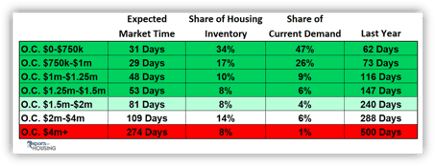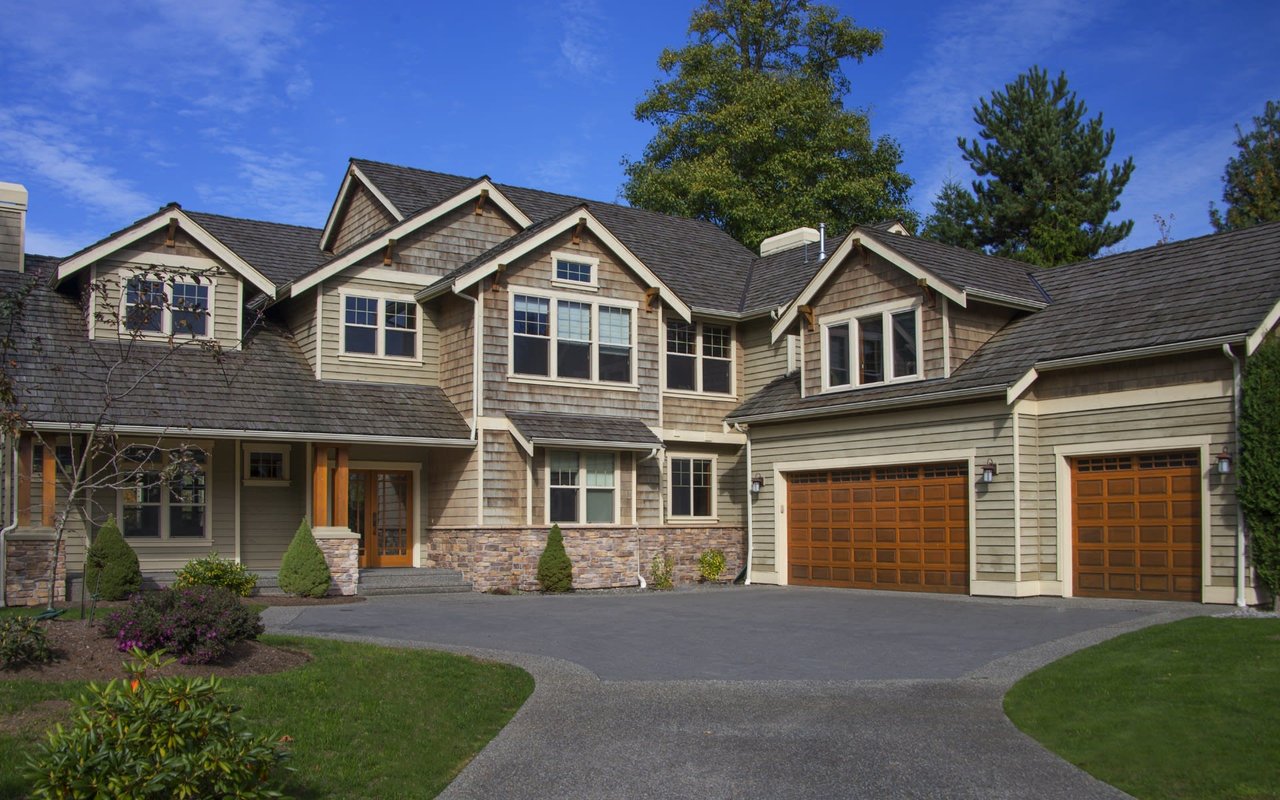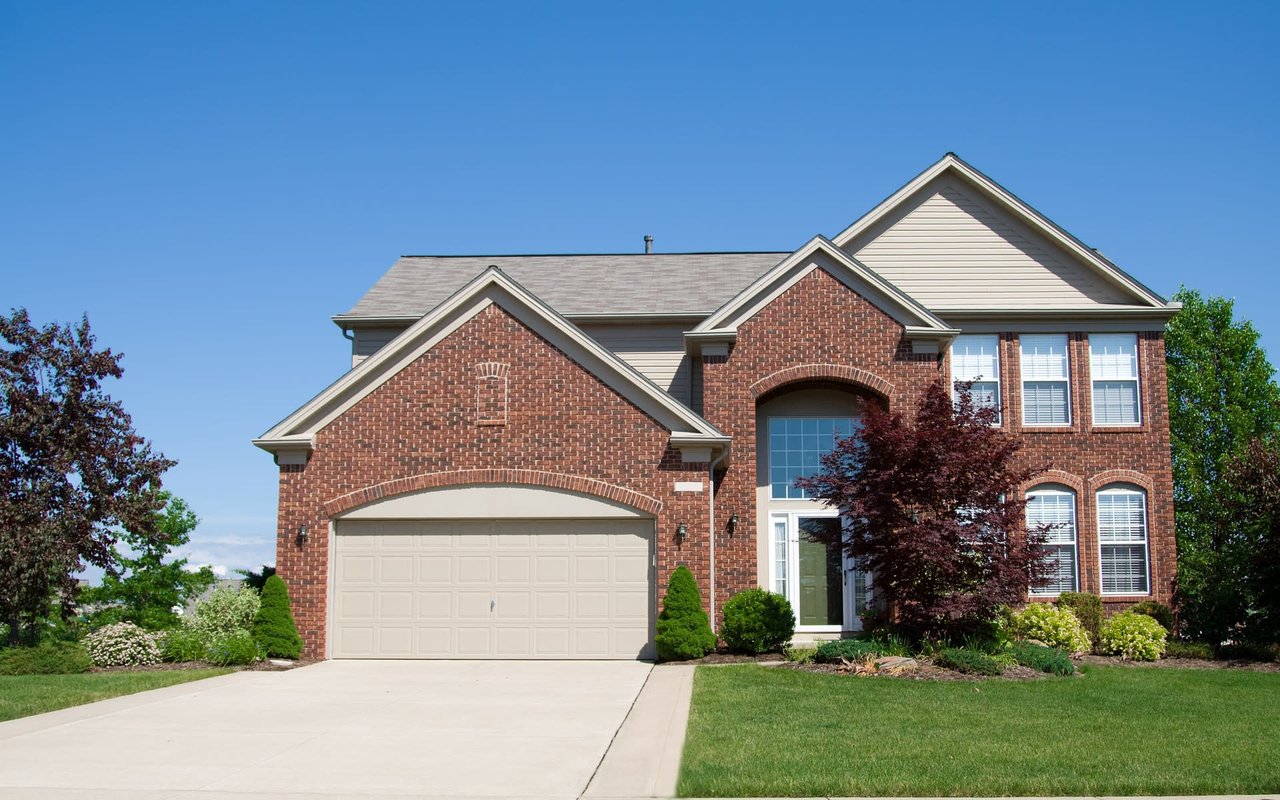With a low supply and strong demand, the market has not been this hot since 2013.
It was sudden. It was unnerving. Nobody had seen anything like it in their lifetime. A pandemic unfolded before everyone’s eyes. That was just four months ago. Since no one had experienced a pandemic and the shutting down of the economy, people turned to hoarding toilet paper and cleaning products, and stocking their cupboards and refrigerators. Yet, slowly but surely, everyone began to adapt to a “new normal,” living with a virus. Businesses turned to Zoom to keep industries moving along. Dining out shifted to DoorDash, Grubhub and Uber Eats. New car dealers turned to online listings and “virtual” test drives. The real estate industry adapted as well with masks, gloves, physical distancing, and a myriad of contracts that outlined the proper protocols needed to sell homes.
While unemployment is still high and the overall economy is slowly crawling its way out of a forced stoppage, housing has been a bright spot with a “V-Shaped” recovery. It came roaring back and trends have emerged that pave the way to a strong finish to 2020 in Orange County:
The active listing inventory has dropped to unprecedentedly low levels. Even at the start of the year, there were not that many homes on the market. Anything that did come on the market quickly opened escrow. Even prior to the shutdown, the inventory had only increased from 3,901 at the beginning of January to 4,159 by March 5th, an increase of only 7%. In March, it was at low levels last experienced in 2013. During the lockdown, COVID-19 suppressed the number of homeowners coming on the market. In April, there were 54% fewer homes that came on the market compared to the 5-year average. Today, there are only 6% fewer homes entering the fray. COVID-19’s grip on preventing homeowners from listing their homes is disappearing. Yet, the lack of new homeowners coming on the market over the last several months has substantially contributed to the current ultra-low active listing inventory, its lowest end of July level since tracking began in 2004 with only 4,590 homes today. The inventory peak typically occurs anywhere between July and August, but this year it occurred at the end of May with 5,044 homes. It has dropped by 9% since.
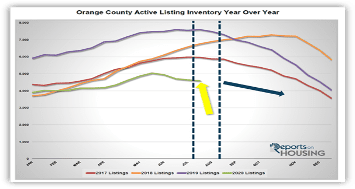
For the rest of the year, expect the inventory to slowly drop as housing transitions to the Autumn Market in August with kids returning to another school year. Families find it less advantageous to make a move during the school year. It will drop further when housing evolves into the Holiday/Winter Market, one week prior to Thanksgiving.
Demand is at its hottest level since 2012. Prior to the virus lockdown at the start of March,
with 3.75% interest rates, demand (the last 30-days of pending sales) had reached 2,583 pending sales, levels not seen since 2015.
Amid the lockdown, COVID-19 suppressed buyer activity and demand dropped to 1,008 pending sales in mid-April, a low last hit in 2008 during the Great Recession. However, the real estate industry adapted and became an essential service. Demand had doubled from its April lows by the end of May and had tripled by the start of July. Interest rates have continued to drop and have reached 3%, a record low. The low mortgage rate environment has been the rocket fuel that has propelled demand to 3,200 pending sales today, its highest level since 2012. And rates are expected to remain at these low levels for the remainder of the year. In Orange County, demand typically peaks between April and May, during the Spring Market, yet that was during the “stay at home” order. Essentially, the Spring Market was postponed, and housing is currently in the middle of the strongest demand of the year and is poised to peak between now and the start of August. For the rest of the year, expect demand to remain strong, fueled by historically low rates. It will downshift slightly as housing transitions to the Autumn Market when kids return to school and fewer families opt to purchase. It will downshift further during the holidays.
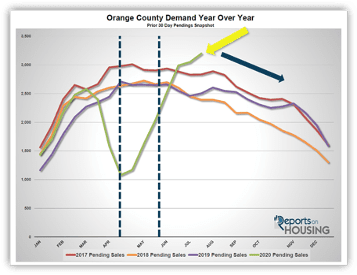
Demand continued to climb, rising by 5% in the past two weeks.
Demand, the number of new pending sales over the prior month, increased from 3,050 to 3,200, an additional 150 pending sales, up 5% in two weeks. This is the highest demand reading since October 2012, nearly eight years ago. Typically demand reaches its peak between April and May, but COVID-19 delayed the absolute best time of the year based upon buyer activity and as of today has not quite reached the 2020 peak. That should occur between now and the start to August.
Last year, demand was at 2,505, that is 695 fewer pending sales compared to today, or 22% less.
In the past two-weeks the Expected Market Time dropped from 46 to 43 days, a Hot Seller’s Market (less than 60 days), where sellers get to call the shots during the negotiating process and home values are on the rise. Last year the Expected Market Time was at 91 days, much slower than today.
The Expected Market Time is at its hottest level since June 2013. The story is not only a “V-Shaped” recovery, its that the market has not been this hot in seven years. The Expected Market Time (the amount of time between hammering in the FOR-SALE sign to opening escrow) is currently at its lowest point of the year, 43 days, and has not been this low in July since 2005. Anything below 60-days is considered a Hot Seller’s Market, where homes are appreciating, and multiple offers is the norm. On March 5th, prior to the lockdown, it was at 48 days, the lowest start to a March since 2013. So, Orange County housing was already pumping on all cylinders. But, by mid-April, the Expected Market Time climbed all the way to 121 days, a slight Buyer’s Market. It quickly reversed course, dropping to 90 days, a Slight Seller’s Market, by mid-May. It dipped below 60 days at the start of June and has never looked back. The Expected Market Time is a statistic that is derived from both supply (the active listing inventory) and demand (recent pending sales). With an ultra-low supply combined with piping hot demand, the Expected Market Time has dropped to unprecedented levels for the middle of summer. As the market transitions into the Autumn Market next month, and both the active inventory and demand slowly drop, the Expected Market Time will gradually rise. It will remain a Seller’s Market for the balance of 2020.
